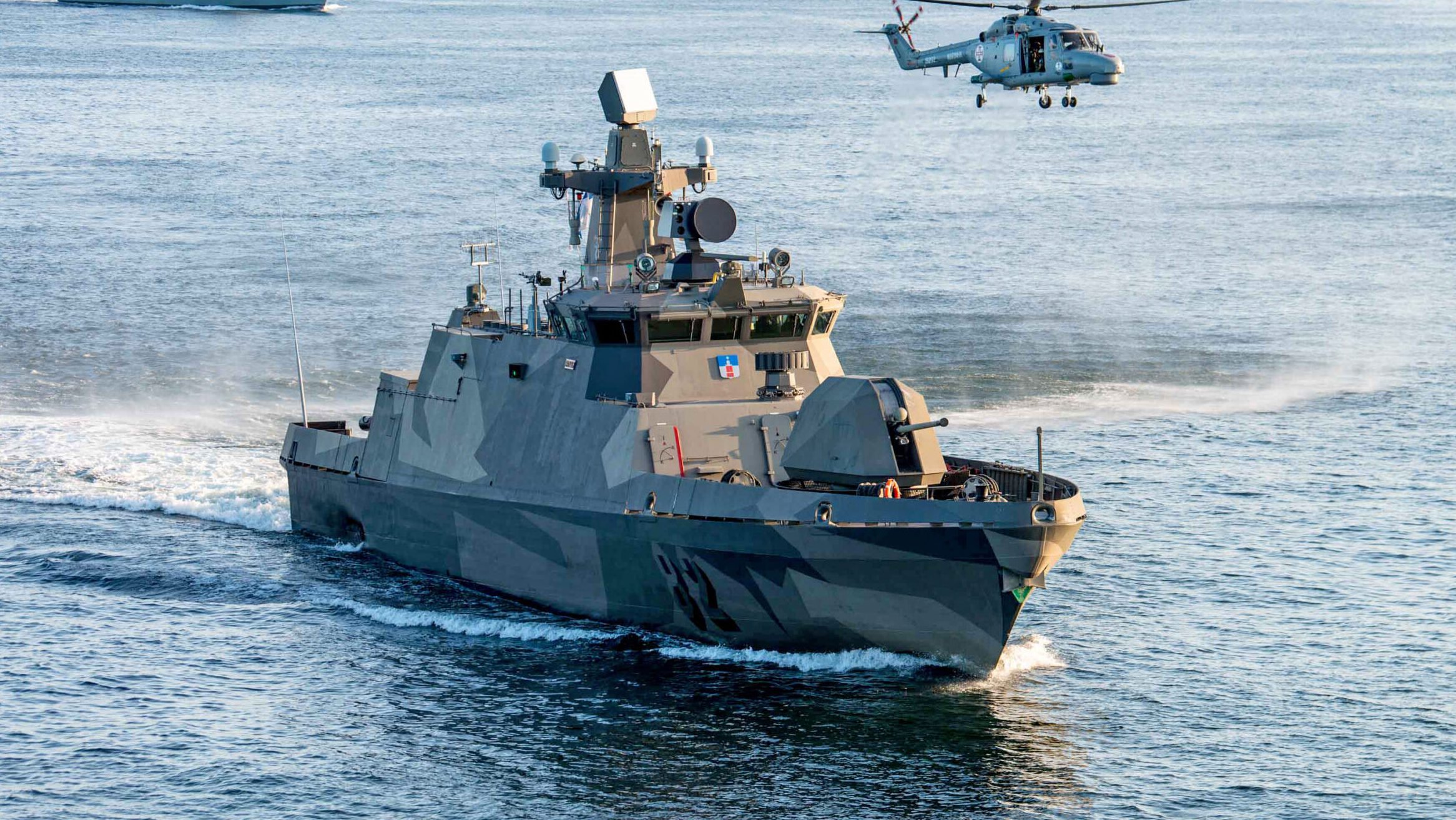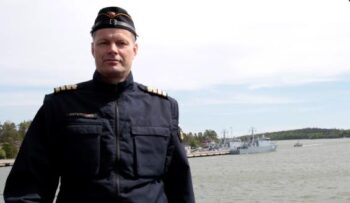
Standing NATO Maritime Group One trains with Finnish FNS Hanko during a 2017 passing exercise in the Baltic Sea. (FRAN CPO Christian Valverde)
SEA AIR SPACE 2023 — This week NATO officially welcomed Finland as its 31st member. What seemed unlikely, if not impossible, just a year ago became official. Now, the questions turn from “what happens if Finland joins NATO” to “how will Finland integrate with its new alliance?”
Hours before Finland historic ascension, Commodore Jukka Anteroinen, chief of staff of the Finnish Navy, appeared on a panel alongside colleagues from Germany, Poland and Sweden at this year’s Navy League Sea Air Space conference. After that talk, he sat down with Breaking Defense to discuss what changes he expects to come from joining NATO, how Russia has treated his naval forces over the last year, and whether Ukraine will spill into the seas.
This interview has been edited for clarity and length.
Breaking Defense: From where you sit as a naval operator, what changes do you anticipate now that you’re joining the NATO alliance? What might change?
Cdre Jukka Anteroinen: Despite the coming membership, our Navy’s [mission] has been, of course, to defend Finland in a time of crisis. And Article Three of NATO in a way dictates or obliges us, we have to take care of our national defense. And our Navy [has] been in a way designed, developed, and also the tactics have been in the way optimized, to meet those requirements. We optimized for our geography and [our] really unique environment, which is a shallow waters with a lot of shoals, 40,000 islands on the Archipelago Sea. The average depth of Archipelago Sea is 23 meters, less than 50 meters to the Gulf of Finland.
It’s too early to say what are really requirements coming from NATO. But still, as I said, our biggest contribution to NATO is to take care of our own land and our own environment. And for that fact, I would say that our ship systems, including coastal troops, have mainly in a way focused on operating in the northern Baltic Sea. The upcoming Corvettes, they [have] the endurance, sea-going capabilities, size, as well as the armament systems [to] take them outside of Baltic Sea if required. Likewise, [mine countermeasure vehicles, MCMVs] we have already because we’ve been in the NATO Response Force, even as a partner. So we deployed one of our MCMVs to NATO’s standing maritime countermeasure [forces] for six weeks.
I guess that the baseline is, once again, it is to be seen whether we are in the way tasked [by NATO] to start doing something else. But as you know, the requirements are basically based on your GDP, your number, the number of people you have in your country, etc., and also the existing force. So I would, I would say not [to predict] a dramatic change, at least in the short term. Capabilities — I mean, equipment, people trained people, doctrines, tactics, concepts — how they are evolved, and how they are developed, it takes years, tens of years.
During the panel you mentioned unmanned a few times. Is that an area you think you can bring something new to NATO?
We have advanced unmanned systems within the Navy, especially in the area of mine countermeasures. And then of course, nowadays there’s a lot of the small, let’s say tactical unit-level unmanned drones. [There are also] long lasting sea surveillance, intelligence capabilities, and of course increased number of advanced underwater unmanned systems. But to me, it’s a bit early, it’s too early to speak about surface units. And Finland is now also developing minesweeping capabilities besides a mine hunting capability we have. We have older, sweeping capability, but we are in a way modernizing it. And currently, one option is to make them unmanned. So those are [something where] especially with NATO, can bring to the table.

Jukka Anteroinen, pictured in a 2019 photo. (Finnish Navy)
You also talked on the panel about maritime information sharing and how you have longstanding agreements with Sweden. I’m wondering how that might be impacted as you join NATO, given that Sweden, at least for now, is not a part of the alliance.
I would put it that we have, let’s say, practice there. But besides practice, we have a technical solution that is based now just on Finnish technology. Finland and Sweden, for instance, have the same technical system for having these maritime pictures presented, as well as Estonia as well as Lithuania. So those countries have got it. But [it’s important to remember] it is not the presentation and processing system, it is the data performance [that matters most]. We have a running system with procedures with Sweden, and it’s different between Sweden and Finland. So in between Finland and Sweden, we can share raw data, and then you present and then you process it as well as you like. So it’s a different level of granularity and a different level of kind of data or information you can take advantage of.
Is that going to suffer then with you in the alliance and Sweden outside?
No, no, no. No, definitely [not]. So within NATO now, there are many bilateral, multilateral arrangements regional [agreements]. And our point of view is that these bilateral multilateral arrangements are not dead. Even [as part of] NATO, and how things will evolve later on, it is to be seen. So that’s my view on that.
Over the last year, we’ve seen a lot of reports about unsafe interactions between Russian forces and those from the US, including, most notably, downing a US drone just last month. Have you seen anything like that from Finland’s naval interactions with Russian forces?
On a tactical level, I would say that on average, generally, they’ve acted professionally and in accordance with their code of conduct, how professionals act. And from our perspective, we haven’t in the way, for example, seen any increase in territorial integrity violations by Russians. So they purposefully have not tried to discredit or harass or somehow provoke us.
So pretty normal interactions then.
Pretty normal. Of course, every now and then [there is an incident]. But I mean, the big trend, you cannot say the big trend [is] that they have really changed their attitudes, their behavior at sea, at the unit level. And as you know, the corridor — because Russian’s have to use the Gulf of Finland, which is very narrow, and especially the international water space — so you could in a way, [see] a lot of trouble there. So you have to have to have some understanding how to navigate, how to, in a way, follow the rules of the road.
We heard your German colleague on the panel say he is “convinced the Russian navy will come out of the war” stronger than at the start of it. Do you agree with that assessment?
Eventually [yes]. I would say that it’s really too early to say how these will in a way evolve. And what is the timeframe? How Russia, their national resources, I mean, [their] national assets, their resource funds, how they can in a way, keep up the naval program, building programs they have had. Can they boost them up? What really do they have technology? Are there some [import bans] embargoes that [hurt their ability to build ships]? So that’s what I mean that “eventually.”
It’s hard — it’s too early to say how fast — but when we look at what has happened in the Baltic Sea, and once again, it’s a public information, they brought, during the Ukraine crisis, new long-range capable surface units to the Baltic Sea. And perhaps it’s some kind of indirect analysis that they haven’t in a way needed those units [in] the Black Sea or Sea of Azov. In general, the war has had less effect on the Baltic Fleet. It seems to be that more or less their capabilities are intact and even a bit strengthened in the Baltics now. But once again, sorry, I’m not a palm-reader in that sense. I would say that it’s still quite fuzzy in that sense of what will happen, when it will happen.
The Ukraine conflict has, largely, been contained to a land conflict. Do you foresee it ever slipping out into the waters in a more direct way?
Of course, the main events take place somewhere in Donbas, or wherever the front line is, and the whole world is focusing there. But still, you can read it from public sources, [Russia] has employed, launched long-range weapon systems [regularly] from the Black Sea. And then if you consider the whole thing, you have to also consider things that have gone the kind of under the [radar] screen, what’s taking place in Black Sea. For example, the grain transportation — the Russians are agreeing on that. There is the Montreux Convention that has implication [over the] use of the Bosphorus, there are mine countermeasure operations ongoing by Bulgaria and Romania. So there [are things] happening. Of course, it’s not the major theater of war, it’s the sidelines. But [there are] implications about the second- or third-degree effects. As you know, the sea lines of communications are vital for Ukraine to have that grain, sunflower oil [shipped out.] So that’s kind of my, perhaps, food for thought rather than giving you direct answers.
Let me put it this way — do you foresee direct conflict between Russia and Ukraine on the water in the near future?
Hard to say, hard to say. It hasn’t happened. What are, really, the kind of capabilities Ukraine possess, that they can, in a way challenge the Russians? What happened to the Moskva, it was, of course, [launched from the land]. So it’s not a symmetric naval warfare [situation]. Really, there is no parity.























